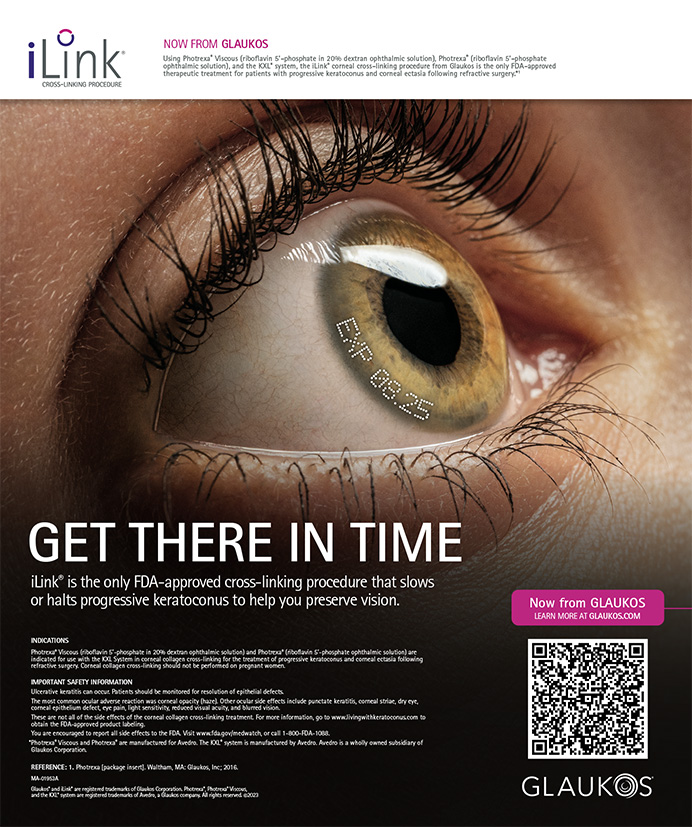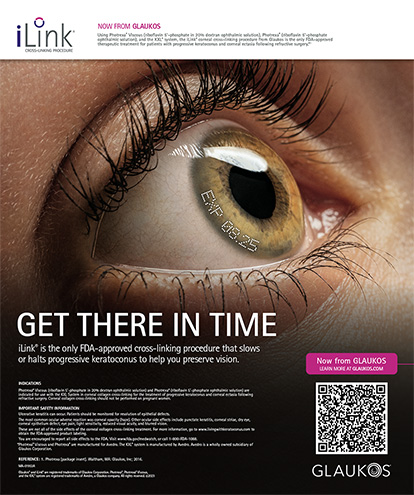What is your current policy on contact lens abstinence prior to patients’undergoing wavefront-guided laser vision correction for regular daily-wear soft contact lenses, toric daily-wear soft contact lenses,and extended-wear soft contact lenses?
STEVEN J. DELL, MD
The short answer is that contact lens abstinence is needed until topographic corneal stability is achieved. Historically, I have recommended 2 weeks of abstinence for soft contact lenses of any kind. In some cases, even this is insufficient. On the other hand, some patients struggle with 2 weeks of spectacle use. Although I have seen data suggesting that subtle topographic changes can persist well beyond 1 week in patients who use spherical dailywear soft contact lenses (DWSCL), clinically, I am not sure how often this is relevant. In many DWSCL patients, I feel confident that 1 week of abstinence is sufficient. I ask toric DWSCL patients and patients who use extended-wear soft contact lenses (EWSCL) to use spectacles for 2 weeks.
MARK A. KONTOS, MD
Managing contact lens wear prior to refractive surgery or cataract surgery with specialty lenses can sometimes be tedious. Some patients cannot imagine life without wearing their contacts, and it is particularly difficult dealing with indiciduals who do not own a pair of eyeglasses. I try to get my DWSCL patients to abstain from contact lens wear for at least 2 weeks. If their topography looks normal during the screening visit, I will shorten the length of time. For patients in toric DWSCLs or for dedicated overnight wearers, I ask them to discontinue wear for a full 3 weeks and try to impress upon them the importance this cessation has on the success of their surgery. I ask hard lens wearers and some toric DWSCL patients to abstain until their topography stabilizes, however long that may take. Every step lays the foundation for the next in refractive surgery. I strive to eliminate contact lens effect as a factor in a successful outcome.
COLMAN R. KRAFF, MD
My policies regarding contact lens abstinence prior to laser vision correction for DWSCL patients is 1 week, but I recommend 2 weeks on the theory that molding of the cornea (although rare) can occur. I also recommend 1 week for EWSCL patients and wearers of rigid gas permeable contact lenses.
I find it is important to compare topographies from before and after lens abstinence, if possible. If there is any lack of stability, I have the patient wait longer. More recently, I have started DWSCL patients on topical loteprednol etabonate ophthalmic suspension 0.5% (Lotemax; Bausch + Lomb) q.i.d and azithromycin ophthalmic solution (AzaSite; Merck & Co., Inc.) q.h.s at the start of abstinence until the patient has his or her preoperative test.
LOUIS E. PROBST, MD; JOHN LEHR, OD; DAWN HOLSTED, OD; AND JO’EL STURM, OD
The short answer is that contact lenses should not be worn until the refraction is stable. The practical answer is that contact lenses should not be worn for 1 week before refractive surgery measurements. The official answer is 2 weeks for regular and 3 weeks for toric DWSCL and EWSCL patients. Why so long? Studies have shown that the manifest refraction can take 10.7 ±10.4 days to stabilize after the discontinuation of contact lense wear, with EWSCL patients taking the longest to stabilize.1
The CustomVue Patient Information Booklet recommends 2 to 4 weeks of abstinence, and the StarS4IR: Indications, Contraindications, Warnings, and Precautions 0030-4482C (both from Abbott Medical Optics Inc., Santa Ana, CA), which recommends 2 weeks of abstinence. Both state that extended periods of contact lens abstinence are necessary prior to refractive surgery measurements. In this era of increased regulatory scrutiny of refractive surgery, the refractive surgeon and comanaging doctor must consider all of these factors in their recommendations on contact lens abstinence .
MITCHELL C. SHULTZ, MD
Currently I am using the Allegretto Wave excimer laser (Alcon Laboratories, Inc., Fort Worth, TX) to perform wavefront-optimized treatments on most of my patients with great success. However, when I believe that a patient will benefit from a wavefront-guided treatment, I am rigid about contact lens discontinuation prior to surgical planning.
I ask patients using 2-week, planned-replacement DWSCLs, with no evidence of corneal asymmetry, to discontinue contact lens wear 1 week prior to the final wavefront analysis. If asymmetry is evident, I ask them to discontinue contact lens wear 2 weeks prior to surgery. I ask patients using toric DWSCLs to abstain from contact lens wear for 2 weeks. Finally, I ask patients using EWSCLs or rigid gas permeable lenses to stop wearing their lenses for 3 weeks, at which time I reassess their corneal symmetry. If any asymmetry is present, I ask them to continue to abstain from contact lens wear for an additional 2 to 4 weeks (although this scenario is extremely rare) before moving forward with treatment.
KARL G. STONECIPHER, MD
I recommend 5 to 7 days of contact lens abstinence for DWSCL patients and 2 to 3 weeks for toric DWSCL patients. As long as they do not have giant papillary conjunctivitis or severe neovascularization, I treat EWSCL patients just like DWSCL patients using the new lenses with higher Dk. All patients are rechecked with computed tomography on the day of surgery and warned that if there are any issues with contact lens-related anomalies, their surgery will be rescheduled.
Section Editor John F. Doane, MD, is in private practice with Discover Vision Centers in Kansas City, Missouri, and he is a clinical assistant professor with the Department of Ophthalmology, Kansas University Medical Center in Kansas City, Kansas. Dr. Doane may be reached at (816) 478-1230; jdoane@discovervision.com.
Steven J. Dell, MD, is the director of refractive and corneal surgery for Texan Eye in Austin and chief medical editor of Cataract & Refractive Surgery Today’s sister publication Advanced Ocular Care. Dr. Dell may be reached at (512) 327-7000.
Dawn Holsted OD, is the vice president of clinical affairs for TLC Laser Eye Centers in Oklahoma City. She acknowledged no financial interest in the products or company she mentioned. Dr. Holsted may be reached at (405) 842-6308.
Mark A. Kontos, MD, is a partner of Empire Eye Physicians, PS, of Washington and Idaho. Dr. Kontos may be reached at (509) 928-8040; mark.kontos@empireeye.com.
Colman R. Kraff, MD, is the director of refractive surgery at the Kraff Eye Institute in Chicago. He acknowledged no financial interest in the products or companies he mentioned. Dr. Kraff may be reached at (312) 444-1111; ckraff@kraffeye.com.
John Lehr OD, is the clinical direct of TLC Laser Eye Centers-Chicago in Westchester. He acknowledged no financial interest in the products or company he mentioned Dr. Lehr may be reached at (708) 562-2020; john.lehr@tlcvision.com.
Louis E. Probst, MD, is the national medical director of TLC Laser Eye Centers in Chicago; Madison, Wisconsin; and Greenville, South Carolina. He is a consultant to Abbott Medical Optics Inc. Dr. Probst may be reached at (708) 562-2020.
Mitchell C. Shultz, MD, is in private practice and is an assistant clinical professor at the Jules Stein Eye Institute, University of California, Los Angeles. He acknowledged no financial interest in the product or company he mentioned. Dr. Shultz may be reached at (818) 349-8300; izapeyes@gmail.com.
Karl G. Stonecipher, MD, is the director of refractive surgery at TLC in Greensboro, North Carolina. Dr. Stonecipher may be reached at (336) 288-8523; stonenc@aol.com.
Jo’el Sturm, OD, is the executive director of TLC Laser Eye Centers, Tulsa, Oklahoma. She acknowledged no financial interest in the products or company she mentioned. Dr. Sturm may be reached at (918) 398-6565.; joel.sturm@tlcvision.com
- Wearing Ng LT,Lee EM,Nguyen AL.Preoperative assessment of corneal and refractive stability in soft contact lens wearing photorefractive candidates.Optom Vis Sci. 2007;84(5):401-409.


